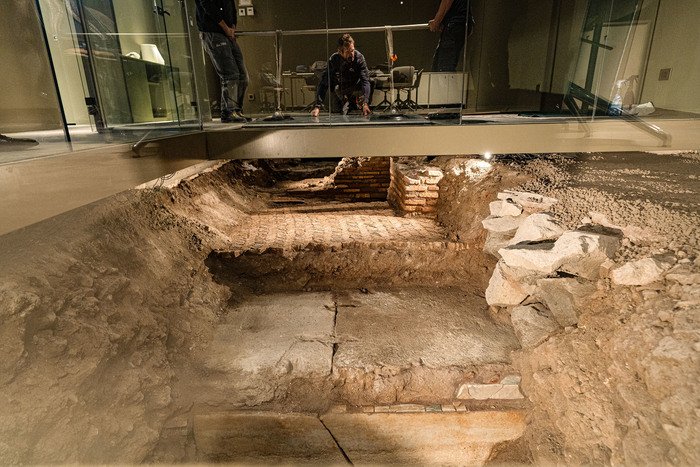ROME - The blue of the decorative band shines in the darkness.
A little further on, you can see a mosaic with two-tone tiles.
And then, the most important discovery, with two rows of peperino blocks from the imperial era which for the first time precisely mark the eastern limit and the raised decorations, that is, those which allow a new three-dimensional dimension to be given to the building.
This is how the Porticus Minucia, one of the places dearest to the Romans because it was the site of the frumentationes, the free distributions of grain to the people of the city, until the 3rd AD, emerged from the foundations of Palazzo Lares Permarini, in via delle Botteghe Oscure, in southern part of Campo Marzio.
The discovery, which saw the collaboration between Finint Investments and the Special Superintendence of Rome, occurred during the renovation works of the building, where the new 5-star hotel of the Radisson Collection line will open its doors from March 28th, but will be accessible to all the public, not just the guests of the facility.
"Rome never ceases to offer surprises and new elements of knowledge", says superintendent Daniela Porro.
The discovery, he says, gives scholars "a new fundamental piece of knowledge of the Porticus", whose "location was also known thanks to the Forma Urbis", but of which "today it is possible to reconstruct in an extremely reliable way, and as never before, the look".
Built by Marco Minucius Rufus after the triumph over the Scordisci in 106 BC and among the buildings rebuilt by Domitian after the fire of 80 AD, the Porticus Minucia in the imperial age was composed of a large quadriportico with double colonnades surrounding a vast open-air square .
In the centre, an imposing temple, identified by some as the one for the Permarine Lares and by others with the temple of the Nymphs, surrounded by fountains.
"Scholars knew it was here - continues Porro -. Some remains can also be seen in front, at the Crypta Balbi, one of the four locations of the National Roman Museum. But in some way we only knew the base, the flooring".
"The discovery is exceptional for the historical significance of the monument - adds the archaeologist Marta Baumgartner -. It was a stroke of luck, a bit controlled", she smiles.
In that area of the Palace the original project in fact envisaged technical rooms for the hotel's systems.
"We did a core drilling, that is, a vertical drilling at great depth - she explains - and from there a significant portion of travertine was identified. At that point we asked the company to be able to investigate further, hoping to find exactly what we found" .
The owners, he underlines, "not only became passionate about it, but they trusted us".
Here then, in the museum space set up by modifying the original project, complete with a video that contextualizes and reconstructs the Porticus in 3D, those blocks of peperino with the housings for the iron grappas that constituted the elevation of the wall can be seen returned to light, the colored marble coverings coming from every part of the empire, portions of flooring in travertine flakes and also pieces of masonry from buildings that abutted the Porticus in a subsequent phase". A great result, says Mauro Sbroggiò, CEO of Finint Investments, the result of the collaboration between "a sensitive superintendency and a private investor attentive to urban regeneration and the context in which it operates.
Now we are studying the methods of visiting with our own guides, but also by contacting those who work in the city, so that they know that here is a fundamental stage in the history of ancient Rome."
Reproduction reserved © Copyright ANSA

